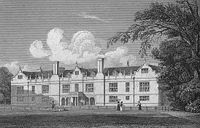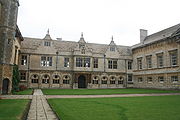
Apethorpe Hall
Encyclopedia

Apethorpe
Apethorpe is a village and civil parish in East Northamptonshire district of the shire county of Northamptonshire, England. The 2001 census records a population of 133....
, Northamptonshire
Northamptonshire
Northamptonshire is a landlocked county in the English East Midlands, with a population of 629,676 as at the 2001 census. It has boundaries with the ceremonial counties of Warwickshire to the west, Leicestershire and Rutland to the north, Cambridgeshire to the east, Bedfordshire to the south-east,...
, England
England
England is a country that is part of the United Kingdom. It shares land borders with Scotland to the north and Wales to the west; the Irish Sea is to the north west, the Celtic Sea to the south west, with the North Sea to the east and the English Channel to the south separating it from continental...
is a Grade I listed country house, dating back to the 15th century.
The house is built around three courtyards lying on an east-west axis and is approximately 120 feet (36.6 m) by 240 feet (73.2 m) in area. It is acknowledged as one of the finest Jacobean
Jacobean architecture
The Jacobean style is the second phase of Renaissance architecture in England, following the Elizabethan style. It is named after King James I of England, with whose reign it is associated.-Characteristics:...
houses in England, and was the main seat of the Fane
Fane (surname)
Fane is an English surname of Welsh origins that belongs to a family who have produced a number of notable members. The family originated with Ivon Vane, who was a Welsh landowner and mercenary captain in the service of the Black Prince. Ivon Vane or John Fane, as he was known in English, was one...
family.
In its prime, the hall entertained much royalty, including Queen Elizabeth I
Elizabeth I of England
Elizabeth I was queen regnant of England and Ireland from 17 November 1558 until her death. Sometimes called The Virgin Queen, Gloriana, or Good Queen Bess, Elizabeth was the fifth and last monarch of the Tudor dynasty...
, King James I
James I of England
James VI and I was King of Scots as James VI from 24 July 1567 and King of England and Ireland as James I from the union of the English and Scottish crowns on 24 March 1603...
and Charles I
Charles I of England
Charles I was King of England, King of Scotland, and King of Ireland from 27 March 1625 until his execution in 1649. Charles engaged in a struggle for power with the Parliament of England, attempting to obtain royal revenue whilst Parliament sought to curb his Royal prerogative which Charles...
who between them made some thirteen visits to the house.
History

Henry Keble
Sir Henry Keble was a grocer and Lord Mayor of London in 1510, in the second year of King Henry VIII's reign.Sir Henry was a leading grocer in London. He was a Merchant of the Staple in Calais. He was originally from Coventry, but had settled in the parish of St Mary Aldermary. He was six times...
, whose grandson was Lord Mountjoy
Charles Blount, 5th Baron Mountjoy
Charles Blount, fifth Baron Mountjoy was an English courtier and patron of learning.-Life:Charles Blount was born on 28 June 1516 in Tournai, where his father, William Blount, 4th Baron Mountjoy, was governor. Charles Blount's mother was William 's second wife, Alice, daughter of Henry Keble, Lord...
, who sold them to King Henry VIII of England
Henry VIII of England
Henry VIII was King of England from 21 April 1509 until his death. He was Lord, and later King, of Ireland, as well as continuing the nominal claim by the English monarchs to the Kingdom of France...
.
Subsequently the property passed to Sir Walter Mildmay
Walter Mildmay
Sir Walter Mildmay was an English statesman who served as Chancellor of the Exchequer of England under Queen Elizabeth I, and was founder of Emmanuel College, Cambridge.-Early life:...
, Chancellor of the Exchequer
Chancellor of the Exchequer
The Chancellor of the Exchequer is the title held by the British Cabinet minister who is responsible for all economic and financial matters. Often simply called the Chancellor, the office-holder controls HM Treasury and plays a role akin to the posts of Minister of Finance or Secretary of the...
. From the windows on the east side of the hall, Mildmay watched the procession announcing the arrival at the house of Elizabeth I of England
Elizabeth I of England
Elizabeth I was queen regnant of England and Ireland from 17 November 1558 until her death. Sometimes called The Virgin Queen, Gloriana, or Good Queen Bess, Elizabeth was the fifth and last monarch of the Tudor dynasty...
. Apethorpe was one of the queen's favourite overnight stops on the Great North Road
Great North Road (Great Britain)
The Great North Road was a coaching route used by mail coaches between London, York and Edinburgh. The modern A1 mainly follows the Great North Road. The inns on the road, many of which survive, were staging posts on the coach routes, providing accommodation, stabling for the horses and...
.

Francis Fane, 1st Earl of Westmorland
Francis Fane, 1st Earl of Westmorland, KB head of the Fane family, of Mereworth in Kent, and then of Apethorpe in Northamptonshire, was first a Member of Parliament and then an English peer...
(1617), who later became the Earl of Westmorland
Earl of Westmorland
Earl of Westmorland is a title that has been created twice in the Peerage of England. The title was first created in 1397 for Ralph Neville. It was forfeited in 1571 by Charles Neville, 6th Earl of Westmorland for leading the Rising of the North. It was revived in 1624 in favour of Sir Francis...
- it remained in the Fane
Fane (surname)
Fane is an English surname of Welsh origins that belongs to a family who have produced a number of notable members. The family originated with Ivon Vane, who was a Welsh landowner and mercenary captain in the service of the Black Prince. Ivon Vane or John Fane, as he was known in English, was one...
family. However, the 12th Earl and his son, the 13th Earl, came into financial difficulties and, in 1904, the family seat was sold to Henry Brassey
Henry Brassey
Henry Arthur Brassey DL was a British Member of Parliament.Brassey was the son of the railway contractor Thomas Brassey and his wife Maria . Thomas Brassey, 1st Earl Brassey, was his elder brother and Albert Brassey his younger brother...
, later Lord Brassey of Apethorpe
Baron Brassey of Apethorpe
Baron Brassey of Apethorpe, of Apethorpe in the County of Northampton, is a title in the Peerage of the United Kingdom. It was created in 1938 for Sir Henry Brassey, 1st Baronet, who had previously represented Northamptonshire Northern and Peterborough in the House of Commons as a Conservative...
.
After World War II much of the adjoining parkland was sold and the house became an approved school
Approved School
Approved School is a term formerly used in the United Kingdom to mean a particular kind of residential institution to which young people could be sent by a court, usually for committing offences but sometimes because they were deemed to be beyond parental control...
. In 1982 the school closed down and in 1983 the building was sold to a Libyan businessman, Wanis Mohamed Burweila, for £750,000. Mr Burweila, who made his money in electronics, wanted to found Britain's first Libyan University in the cloisters and courtyards of Apethorpe. The shooting of WPC Yvonne Fletcher at the Libyan embassy siege in 1984 put paid to these plans, however, and, along with much of Britain's immigrant Libyan community, Mr Burweila left the country.
Burweila left the building vacant leading to its deterioration; this in turn led to him, in 2001, being served a Statutory Repairs Notice, which is an order from the Secretary of State for Culture, Media and Sport
Secretary of State for Culture, Media and Sport
The Secretary of State for Culture, Olympics, Media and Sport is a United Kingdom cabinet position with responsibility for the Department for Culture, Media and Sport. The role was created in 1992 by John Major as Secretary of State for National Heritage...
, requiring him to undertake certain urgent works to ensure the future of the building. In order to avoid doing this, Burweila sold the property to a developer called Kestral Armana Ltd, (subsequently renamed Apethorpe Country Estate Ltd (ACEL)).
The hall was empty for twenty years from the late 1970s and was becoming dangerously unsafe, with incipient damp and rot. When English Heritage
English Heritage
English Heritage . is an executive non-departmental public body of the British Government sponsored by the Department for Culture, Media and Sport...
started its Buildings at Risk Register in 1998, the hall was included on it. In September 2004 the Hall was compulsorily purchased
Compulsory purchase order
A compulsory purchase order is a legal function in the United Kingdom and the Republic of Ireland that allows certain bodies which need to obtain land or property to do so without the consent of the owner. It may be enforced if a proposed development is considered one for public betterment - for...
by the Government under section 47 of the Planning (Listed Buildings and Conservation Areas) Act 1990
Planning (Listed Buildings and Conservation Areas) Act 1990
The Planning Act 1990 is an Act of Parliament of the United Kingdom that altered the laws on granting of planning permission for building works, notably including those of the listed building system in England and Wales....
(only the second time the Government has had to use these powers) and English Heritage has spent £4 million refurbishing it to make it waterproof; Stamford restoration and conservation builders, E. Bowman & Sons Ltd, carried out the works. Since 2007 it has been seeking a buyer willing to spend a further £4 million to complete the restoration, without success, as of Spring 2011. In 2008, the asking price was between £4.5 and £5m. In 2011, the house is open to the public for pre-booked guided tours on Wednesdays, Fridays and Saturdays from 1 June to 30 September.
Film location
The house has been used for filming scenes in Another Country and Porterhouse Blue.The restoration and attempts to sell the property were the subject of a fly on the wall
Fly on the wall
Fly on the wall is a style of documentary-making used in filmmaking and television production. The name derived from the idea that events are seen candidly, as a fly on a wall might see them...
documentary first shown on BBC Two
BBC Two
BBC Two is the second television channel operated by the British Broadcasting Corporation in the United Kingdom. It covers a wide range of subject matter, but tending towards more 'highbrow' programmes than the more mainstream and popular BBC One. Like the BBC's other domestic TV and radio...
in April 2009.
Further reading
- Pete Smith in English Heritage Historical Review, vol. 2, 2007 (The Palladian Palace at Apethorpe, ppps. 84-105).
- Jennifer S. Alexander & Kathryn A. Morrison in Architectural History, vol. 50, 2007 (Apethorpe Hall and the workshop of Thomas Thorpe, mason of King's Cliffe: a study in masons' marks, ppps. 59-94).

